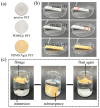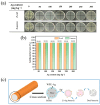Green Method for the Preparation of Durable Superhydrophobic Antimicrobial Polyester Fabrics with Micro-Pleated Structures
- PMID: 38542857
- PMCID: PMC10974891
- DOI: 10.3390/molecules29061219
Green Method for the Preparation of Durable Superhydrophobic Antimicrobial Polyester Fabrics with Micro-Pleated Structures
Abstract
To produce functional protective textiles with minimal environmental footprints, we developed durable superhydrophobic antimicrobial textiles. These textiles are characterized by a micro-pleated structure on polyester fiber surfaces, achieved through a novel plasma impregnation crosslinking process. This process involved the use of water as the dispersion medium, water-soluble nanosilver monomers for antimicrobial efficacy, fluorine-free polydimethylsiloxane (PDMS) for hydrophobicity, and polyester (PET) fabric as the base material. The altered surface properties of these fabrics were extensively analyzed using scanning electron microscopy (SEM), Fourier transform infrared spectroscopy (FTIR), X-ray photoelectron spectrometry (XPS), thermogravimetric analysis (TGA), and water contact angle (WCA) measurements. The antimicrobial performance of the strains was evaluated using Gram-negative Escherichia coli and Gram-positive Staphylococcus aureus. After treatment, the fabrics exhibited enhanced hydrophobic and antimicrobial properties, which was attributed to the presence of a micro-pleated structure and nanosilver. The modified textiles demonstrated a static WCA of approximately 154° and an impressive 99.99% inhibition rate against both test microbes. Notably, the WCA remained above 140° even after 500 washing cycles or 3000 friction cycles.
Keywords: antimicrobial property; micro-pleated structure; plasma; superhydrophobicity; water-soluble nanosilver.
Conflict of interest statement
Minglin Xu was employed by the “Langfang Feize Composites Technology Co., Ltd.”. The authors declare that this study received funding from “National Key Research and Development Program of China” and “Major Program of Basic Science in Colleges and Universities of Jiangsu Province”. The funder was not involved in the study design, collection, analysis, interpretation of data, the writing of this article or the decision to submit it for publication.
Figures












Similar articles
-
Antibacterial Superhydrophobic Cotton Fabric with Photothermal, Self-Cleaning, and Ultraviolet Protection Functionalities.ACS Appl Mater Interfaces. 2023 Jul 19;15(28):34031-34043. doi: 10.1021/acsami.3c04598. Epub 2023 Jul 3. ACS Appl Mater Interfaces. 2023. PMID: 37399520
-
Electroless silver plating on fabrics for antimicrobial coating: comparison between cotton and polyester.J Appl Biomater Funct Mater. 2024 Jan-Dec;22:22808000241277383. doi: 10.1177/22808000241277383. J Appl Biomater Funct Mater. 2024. PMID: 39373115
-
Designing a superhydrophobic cotton fiber coating exploiting TiO2@g-C3N4 layered structure for augmented photocatalysis and efficient water-oil separation.Int J Biol Macromol. 2024 Apr;264(Pt 1):130596. doi: 10.1016/j.ijbiomac.2024.130596. Epub 2024 Mar 4. Int J Biol Macromol. 2024. PMID: 38447823
-
Enzymatic Hydrophobic Modification of Jute Fibers via Grafting to Reinforce Composites.Appl Biochem Biotechnol. 2016 Apr;178(8):1612-29. doi: 10.1007/s12010-015-1971-x. Epub 2016 Jan 11. Appl Biochem Biotechnol. 2016. PMID: 26754422 Review.
-
Synthetic vs. natural antimicrobial agents for safer textiles: a comparative review.RSC Adv. 2024 Sep 26;14(42):30688-30706. doi: 10.1039/d4ra04519j. eCollection 2024 Sep 24. RSC Adv. 2024. PMID: 39328870 Free PMC article. Review.
Cited by
-
Chemical Modification of Acrylonitrile-Divinylbenzene Polymer Supports with Aminophosphonate Groups and Their Antibacterial Activity Testing.Molecules. 2024 Dec 23;29(24):6054. doi: 10.3390/molecules29246054. Molecules. 2024. PMID: 39770142 Free PMC article.
References
-
- Massella D., Giraud S., Guan J., Ferri A., Salaün F. Textiles for health: A review of textile fabrics treated with chitosan microcapsules. Environ. Chem. Lett. 2019;17:1787–1800. doi: 10.1007/s10311-019-00913-w. - DOI
-
- Liu J., Qi P., Zhang J., Liu X., Chen F., Li H., Gu X., Sun J., Zhang S. Bio-based phytic acid-induced polypyrrole/silver nanowires coating towards multifunctional nylon/cotton blend fabrics. Chem. Eng. J. 2023;476:146837. doi: 10.1016/j.cej.2023.146837. - DOI
MeSH terms
Substances
LinkOut - more resources
Full Text Sources

